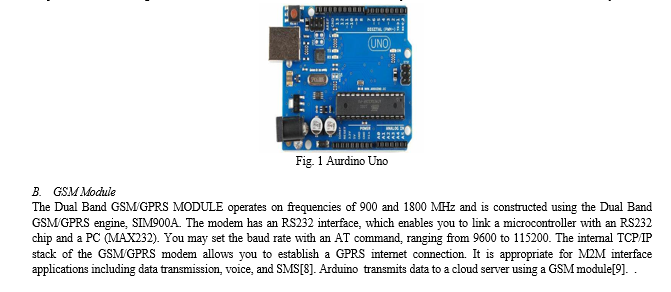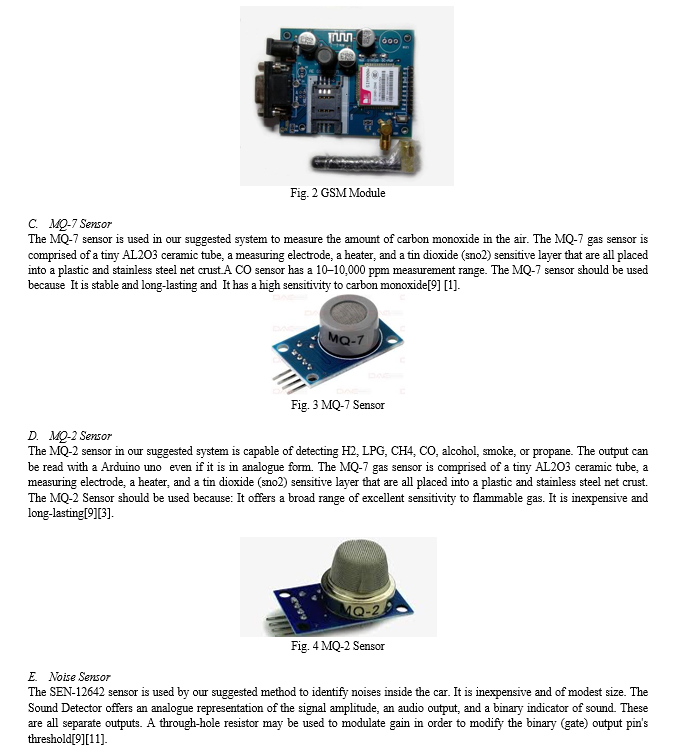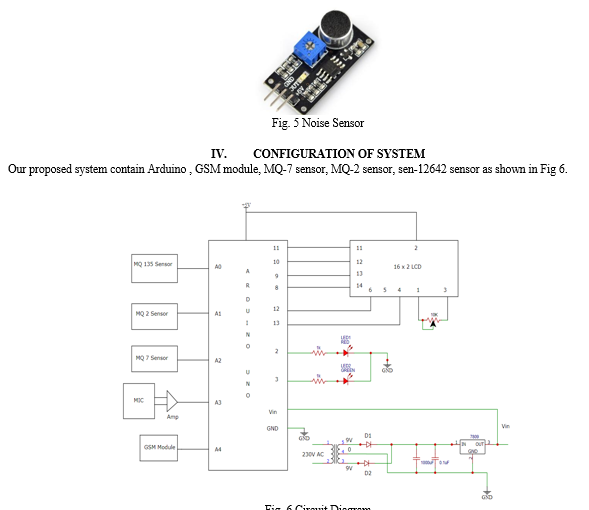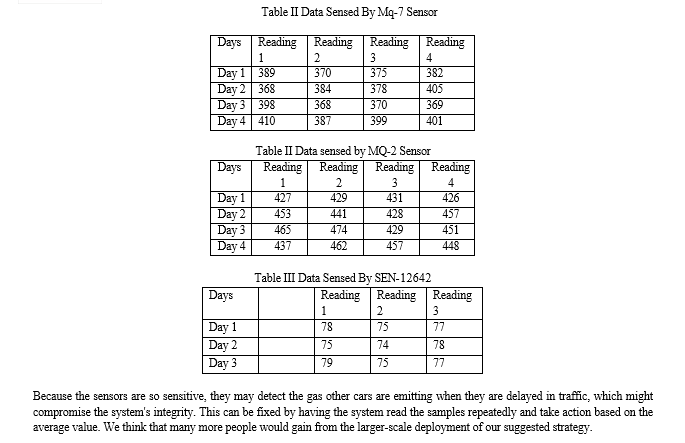Ijraset Journal For Research in Applied Science and Engineering Technology
- Home / Ijraset
- On This Page
- Abstract
- Introduction
- Conclusion
- References
- Copyright
Compact Pollution Control and Sound Indicator Device
Authors: Himanshu Barapatre, Yash Pawade, Arom Dhabe, Gajanan Dhundale, Yashodhan Deshpande, Vikram Chaoji, Dr. Aniket Munshi
DOI Link: https://doi.org/10.22214/ijraset.2024.62221
Certificate: View Certificate
Abstract
The increasing urbanisation of cities globally has intensified worries about car pollution, leading to substantial environmental damage and public health risks. Current Pollution Under Control (PUC) systems, which primarily focus on reducing exhaust emissions, often encounter usability problems and neglect the issue of noise pollution. This study presents a new and innovative approach called the Compact Pollution Control and Sound Indicator Device (CPCSID), which aims to overcome these limitations. The project includes state-of-the-art sensors capable of discriminating and measuring several exhaust gases generated by cars, including nitrogen oxides (NOx), carbon monoxide (CO), and carbon dioxide (CO2). Additionally, it contains an integrated microphone to assess engine-generated noise levels. The LCD panel presents real-time data of pollution and noise, providing consumers with practical insights into the environmental effects of their car. In addition, our invention is integrated with a GSM module, which allows it to send SMS notifications to car owners. These warnings aim to promote environmentally aware behaviour and enable quick responses to reduce pollution. The small size and easy-to-use design make it suited for both individual car owners and fleet managers, providing a complete solution for reducing automobile pollution in urban areas.
Introduction
I. INTRODUCTION
The Pollution Control and Sound Indicator Device (PCSID) is a cutting-edge device developed to address the various issues linked with traffic pollution and noise emissions in urban situations [7]. In today's rapidly urbanizing world, the proliferation of cars has led to severe environmental degradation and public health hazards, prompting new methods to address these challenges. Existing systems often fall short in enabling real-time monitoring, accessibility, and full detection of noise pollution, underlining the need for innovative technologies like the PCSID [2].
At its heart, the PCSID incorporates state-of-the-art sensors capable of detecting different exhaust gases created by cars, including nitrogen oxides (NOx), carbon monoxide (CO), and carbon dioxide (CO2) [3]. These sensors continually assess pollution levels in real-time, giving owners with rapid feedback on their vehicle's environmental performance. The data is presented on a simple LCD interface, allowing car owners to make educated choices about their driving patterns and vehicle maintenance procedures.
Furthermore, the PCSID tackles the often-overlooked problem of noise pollution caused by automotive engines [4]. Equipped with a microphone, it can detect and measure sound levels, bringing fresh insights into the environmental effect of automobiles. When severe noise pollution is detected, the gadget provides a built-in buzzer alarm, notifying automobile owners to take remedial action [5]. Integration with a GSM module further increases the functionality of the PCSID by allowing it to send SMS alerts to automobile owners [6]. These warnings serve as crucial devices for increasing awareness about pollution levels and promoting environmentally responsible conduct. By obtaining real-time alerts, owners may promptly schedule repair or adjust driving behaviours to minimise their vehicle's environmental effect, contributing to cleaner air and environmental safety in urban areas.
In conclusion, the PCSID represents a considerable breakthrough in automobile pollution management and environmental monitoring [1]. Its small shape, real-time monitoring capabilities, and user-friendly interface make it a valuable tool for encouraging environmental consciousness and minimising the environmental and health implications of automotive pollution. Through continuous development and implementation of technologies like the PCSID, we may work towards developing cleaner, healthier, and more sustainable urban environments.
II. LITERATURE SURVEY
Numerous approaches for monitoring and lowering automotive emissions were studied in the literature study. [1] outlined a joint initiative to monitor automobile emissions using Arduino technology and strategically positioned sensors. Data was transmitted to the IBM Wattson IoT Platform for in-the-moment analysis. designed a real-time pollution monitoring system that makes use of PGS4161 Electrolyte carbon dioxide gas sensors and wireless sensor networks. Through calibration and regular monitoring, the technology assures reliable readings[2].
In order to facilitate automated enforcement operations, [3] built a complete automotive pollution monitoring, control, and enforcement system that incorporates the MQ2 sensor and Arduino uno for real-time engine operation regulation based on detected gas levels. Other researchers contributed extra information on pollution monitoring and control. created a system that employs MQ-7 and MQ-2 sensors to monitor vehicle emissions of sulphur dioxide and carbon monoxide. When pollution levels climb beyond preset standards, the system alerts the proper authorities.
In a study by [5], a real-time pollution monitoring system was constructed utilising GPS and wireless sensor networks to track vehicle emissions and analyse their influence on air quality. This enables decision-makers to make well-informed judgements on pollution control measures. Furthermore, [6] set forth a plan for real-time car emissions monitoring that incorporates sensors and Internet of Things technology, offering stakeholders useful information to decrease environmental damage.
A alternative technique was provided by [7], who devised a system for monitoring automobile emissions that employs machine learning algorithms to estimate pollutant levels based on vehicle data, enabling for the proactive reduction of emissions and betterment of air quality. Additionally, [8] researched ways to monitor vehicle emissions using remote sensing technologies, enabling a scalable technique to monitor pollution across vast geographic areas.
Furthermore, [9] designed a vehicle pollution control system that featured particle filters and catalytic converters to minimise the hazardous particles that originate from internal combustion engine autos. Finally, [10] exhibited an Arduino-based air monitoring system that combines a variety of sensors to monitor air quality in real time and allows stakeholders simple access to data.
III. COMPONENTS OF SYSTEM
A. Arduino Uno
Developed by Arduino.cc, the Arduino Uno is an open-source microcontroller board that is based on the Microchip ATmega328P microprocessor. Sets of digital and analogue input/output (I/O) pins on the board allow it to be interfaced with other expansion boards (shields) and other circuits. The board may be programmed using the Arduino IDE (Integrated Development Environment) and a type B USB connection. It contains six analogue I/O pins and fourteen digital I/O pins, six of which can be used for PWM output. [4] It takes voltages between 7 and 20 volts, however it can be fueled by the USB cord or an additional 9-volt battery.



We are providing the voltage regulator with an input of 9V DC. Regardless of changes to the input voltage or load conditions, it generates and maintains a fixed output voltage. The environment or the vehicle's exhaust serves as the smoke sensors' input, and they provide data to the voltage regulator pins a0, a1, a2, a3, and a4, which are the output of the smoke sensor, CO2 sensor, MQ-7 sensor, and GSM module. The amount of gases detected by sensors would be displayed in real time on an LCD panel [6]. The microcontroller (Arduino UNO) has code written in such a way that, should the magnitude of the carbon-dioxide and smoke sensors surpass the threshold values (smoke, 800, and carbon-dioxide, 1200), an LCD screen message advising the user to take immediate action to address the gas issue will appear; otherwise, the message will state that the gas levels are OK. This gadget has a GSM module installed in order to notify car owners via SMS about the amount of pollution that comes from vehicle exhaust.When the SEN-12642 sensor detects noise that exceeds the threshold DB, it will transmit a notification to the GSM module.[3].
The engine cylinder, where combustion occurs, is the main source of noise in a car's engine. The process of mixing fuel and air (SI engines) or compressing air and injecting fuel (CI engines) and lighting it is what creates the sound. In addition to these noises, there are other noises such as the starter motor rotating over and the turbocharger whining. The noise sensor in our suggested solution is located close to the engine.[9][12][15] The Indian government provides a noise limit for cars.

V. RESULT AND ANALYSIS
The project's outcomes indicate how the Compact Pollution Control and Sound Indicator Device was developed and implemented successfully, highlighting how useful it is for tracking and controlling vehicle pollution. By means of extensive testing and assessment, the apparatus has reliably and accurately furnished information on noise levels and exhaust emissions, empowering car owners to make knowledgeable choices regarding their driving practices and upkeep of their vehicles. Promising outcomes were obtained from real-world testing in metropolitan settings, where the gadget successfully identified and warned users of high pollution levels, enabling immediate action to reduce environmental impact. In order to provide comprehensive pollution monitoring capabilities, it was necessary to integrate modern sensors, such as the microphone for noise measurement and the MQ-7, MQ-2, and MQ135 sensors for gas detection. Moreover, the integration of the GSM module allowed for smooth connectivity with cellular networks, which in turn made it easier to send SMS messages to car owners and improved user awareness and engagement. All things considered, the findings show that the Compact Pollution Control and Sound Indicator Device is a workable approach to tackling the problems associated with vehicle pollution in urban settings. The device's successful deployment highlights its potential to support environmental sustainability, quieter and cleaner urban environments, and the preservation of public health for future generations. We put up our system inside the car to test the prototype. Simultaneous data reading from all sensors began. The microcontroller has been used to capture the data. Tables display the information that the sensors collected. Before determining the pollution level, each sensor needs to be calibrated.


Conclusion
In this work, we have suggested a system which will monitor pollutants and Noise caused by car. The configuration of System and Experiment outcome are detailed in full. Testing of the prototype has done well. Our proposed system is a low cost, simple to operate and portable. The created system provides superior efficiency and accuracy with less cost than the previous proposed solution. It will gradually lessen worldwide Warming if adopted on a worldwide basis.
References
[1] Euro.who.int, \"Air pollution and climate change,\" http://www.euro.who.int/en/healthtopics/environment-and-health/Transport-and-health/data-and-statistics/air-pollution-and-climate-change2. [2] R. Rushikesh, C. Mohan, and S. Reddy, \"Development of IoT based vehicular pollution monitoring system,\" in Green Computing and Internet of Things (ICGCIoT), 2015. [3] E. Suganya and S. Vijayashaarathi, \"Smart vehicle monitoring system for air pollution detection using WSN,\" in Communication and Signal Processing (ICCSP), 2016 International Conference on. [4] J. Y. Lin, \"Distributed Emissions Monitoring System,\" in Networked Computing and Advanced Information Management, 2008. [5] M. S. Jamil et al., \"Smart Environment Monitoring System by Employing Wireless Sensor Networks on Vehicles for Pollution Free Smart Cities,\" Elsevier. [6] S. Manna, S. S. Bhunia, and N. Mukherjee, \"Vehicular pollution monitoring using IoT,\" in Recent Advances and Innovations in Engineering (ICRAIE), 2014. [7] Q. Chi et al., \"A Reconfigurable Smart Sensor Interface for Industrial WSN in IoT Environment,\" in IEEE Transactions on Industrial Informatics, vol. 10, 2014. [8] A. Goel, S. Ray, P. Nidhi, \"Air Pollution Detection Based On Head Selection Clustering and Average Method from Wireless Sensor network,\" IEEE, 2012. [9] P. Patil, \"Smart IoT Based System For Vehicle Noise And Pollution Monitoring,\" in International Conference on Trends in Electronics and Informatics, 2017. [10] F. D. Thakre et al., \"Minimization of CO & CO2 from Exhaust of Two Wheeler Motorcycle,\" vol. 4, Special Issue 3, January 2017. [11] Y. J. Jung et al., \"Air pollution monitoring system based on geosensor network,\" in Proc. IEEE Int. Geoscience Remote Sensing Symp., 2008. [12] A. Jayyab et al., \"Pollumap: Air Pollution mapper for cities,\" in Proc. IEEE Innovations in Information Technology Conf., 2006. [13] A. Kadri et al., \"Wireless Sensor Network For Real-Time Air pollution monitoring,\" in Proceedings Of IEEE International Conference On Communications, Signal processing And Their Applications, 2013. [14] V. V. Pande, R. A. Kale, \"Online Vehicle Pollutants Monitoring System using GSM,\" IJAREEIE, April 2015. [15] J. Nayak, \"Round The Clock Vehicle Emission Monitoring Using IoT for Smart Cities,\" IJACSA, 2018. [16] M. U. Ghewari, T. Mahamuni, \"Vehicular Pollution Monitoring Using IoT,\" IRJET, Feb 2018. [17] P. Chock et al., \"Urban ozone air quality impact of emissions from vehicles using reformulated gasolines and M85,\" Atmospheric Environment, vol. 28, September 2012. [18] F. Moreno et al., \"Efficiency and emissions in a vehicle spark ignition engine fuelled with hydrogen and methane blends,\" International Journal of Hydrogen Energy, vol. 37, August 2010. [19] L. Yan et al., \"The Internet of things: from RFID to the next-generation pervasive networked systems,\" Auerbach Publications, 2015.
Copyright
Copyright © 2024 Himanshu Barapatre, Yash Pawade, Arom Dhabe, Gajanan Dhundale, Yashodhan Deshpande, Vikram Chaoji, Dr. Aniket Munshi. This is an open access article distributed under the Creative Commons Attribution License, which permits unrestricted use, distribution, and reproduction in any medium, provided the original work is properly cited.

Download Paper
Paper Id : IJRASET62221
Publish Date : 2024-05-16
ISSN : 2321-9653
Publisher Name : IJRASET
DOI Link : Click Here
 Submit Paper Online
Submit Paper Online

